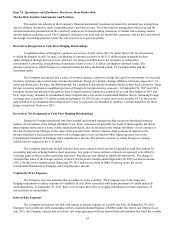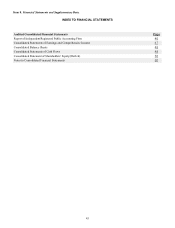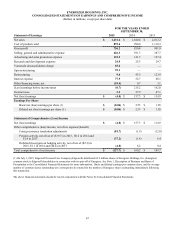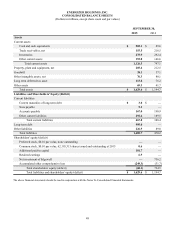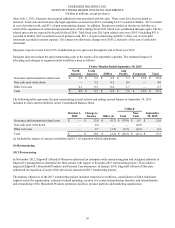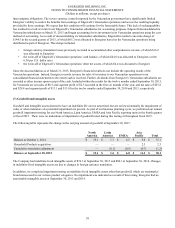Energizer 2015 Annual Report Download - page 55
Download and view the complete annual report
Please find page 55 of the 2015 Energizer annual report below. You can navigate through the pages in the report by either clicking on the pages listed below, or by using the keyword search tool below to find specific information within the annual report.ENERGIZER HOLDINGS, INC.
NOTES TO CONSOLIDATED FINANCIAL STATEMENTS
(Dollars in millions, except per share)
51
(1) Description of Business and Basis of Presentation
Description of Business - Energizer Holdings, Inc. and its subsidiaries (Energizer or the Company) is a global manufacturer,
marketer and distributer of household batteries, specialty batteries and portable lights under the Energizer and Eveready brand
names. Energizer offers batteries using lithium, alkaline, carbon zinc, nickel metal hydride, zinc air and silver oxide
technologies.
On July 1, 2015, Energizer completed its legal separation from Edgewell Personal Care Company (Edgewell) via a tax free
spin-off (the spin-off or spin). To effect the separation, Edgewell, undertook a series of transactions to separate net assets and
legal entities. As a result of these transactions, Energizer now holds the Household Products' product group and Edgewell holds
the Personal Care product group. As a result of the Spin-off, Energizer now operates as an independent, publicly traded
company on the New York Stock Exchange trading under the symbol "ENR."
In conjunction with the spin-off, Edgewell distributed 62,193,281 shares of Energizer Holdings, Inc. common stock to its
shareholders. Under the terms of the spin-off, Edgewell common stockholders of record as of the close of business on June 16,
2015, the record date for the distribution, received one share in Energizer for each share of Edgewell common stock they held.
Edgewell completed the distribution of Energizer common stock to its shareholders on July 1, 2015, the distribution date. The
transaction was structured to be tax-free to its U.S. shareholders for U.S. federal income tax purposes.
Basis of Presentation - The consolidated financial statements include the accounts of Energizer and its subsidiaries. All
significant intercompany transactions are eliminated. Energizer has no material equity method investments or variable
interests.
Prior to the spin-off on July 1, 2015, our financial statements were prepared on a combined standalone basis derived from the
financial statements and accounting records of Edgewell and included expense allocations for: (1) certain product warehousing
and distribution; (2) various transaction process functions; (3) a consolidated sales force and management for certain countries;
(4) certain support functions that were provided on a centralized basis within Edgewell and not recorded at the business division
level, including, but not limited to, finance, audit, legal, information technology, human resources, communications, facilities,
and compliance; (5) employee benefits and compensation; (6) share-based compensation; (7) financing costs; (8) the effects of
restructurings and the Venezuela deconsolidation; and (9) cost of early debt retirement. These expenses were allocated to
Energizer on the basis of direct usage where identifiable, with the remainder allocated on a basis of global net sales, cost of
sales, operating income, headcount or other measures of Energizer and Edgewell. Management believes the assumptions
regarding allocated expenses, reasonably reflect the utilization of services provided to or the benefit received by Energizer
during the periods prior to the spin-off. Nevertheless, the allocations may not include all of the actual expenses that would have
been incurred by Energizer and may not reflect our results of operations, financial position and cash flows had we been an
independent standalone company during the periods prior to July 1, 2015. It is not practicable to estimate actual costs that
would have been incurred had Energizer been a standalone company during the periods prior to the spin-off. Actual costs that
would have been incurred if Energizer had been a standalone company would depend on multiple factors, including
organizational structure and strategic decisions made in various areas, including information technology and infrastructure.
(2) Summary of Significant Accounting Policies
Energizer’s significant accounting policies, which conform to GAAP and are applied on a consistent basis in all years
presented, except as indicated, are described below.
Use of Estimates – The preparation of the Company's Consolidated Financial Statements in conformity with GAAP requires
management to make estimates and assumptions that affect the reported amounts of assets and liabilities, disclosure of
contingent assets and liabilities and the reported amounts of revenues and expenses. On an ongoing basis, Energizer evaluates
its estimates, including those related to customer promotional programs and incentives, product returns, bad debts, the carrying
value of inventories, intangible and other long-lived assets, income taxes, pensions and other postretirement benefits, share-
based compensation, contingencies and acquisitions. Actual results could differ materially from those estimates. However, in
regard to ongoing impairment testing of goodwill and indefinite lived intangible assets, significant deterioration in future cash
flow projections, changes in discount rates used in discounted cash flow models or changes in other assumptions used in
estimating fair values, versus those anticipated at the time of the initial acquisition, as well as subsequent estimated valuations,
could result in impairment charges that may materially affect the financial statements in a given year.




